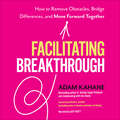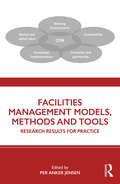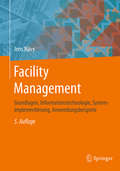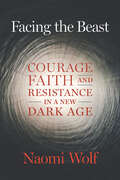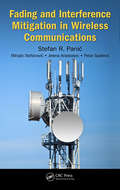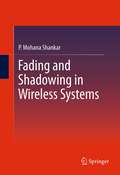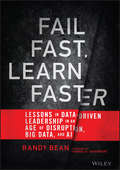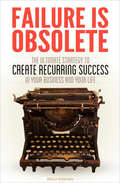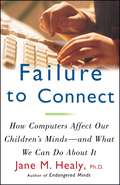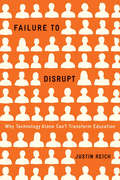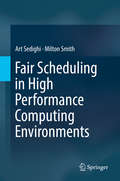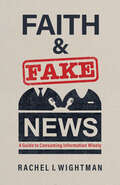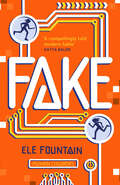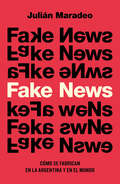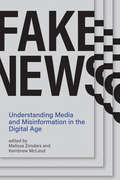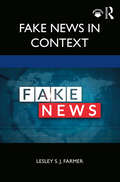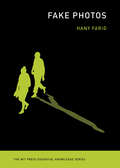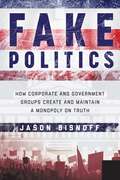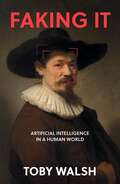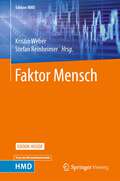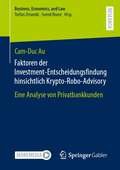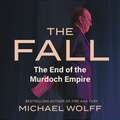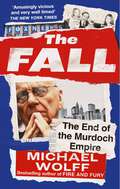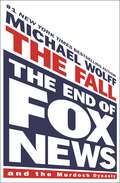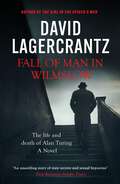- Table View
- List View
Facilitating Breakthrough: How to Remove Obstacles, Bridge Differences, and Move Forward Together
by Adam KahaneMaking progress on complex, problematic situations requires a new approach to working together: transformative facilitation, a structured and creative process for removing the obstacles to fluid forward movement. It is becoming less straightforward for people to move forward together. They face increasing complexity and decreasing control. They need to work with more people from across more divides. In such situations, the most common ways of advancing—some people telling others what to do, or everyone just doing what they think they need to—aren't adequate.One better way is through facilitating. But the most common approaches to facilitating—bossy vertical directing from above or collegial horizontal accompanying from alongside—aren't adequate. They often leave the participants frustrated and yearning for breakthrough.This book describes a new approach: transformative facilitation. It doesn't choose either the bossy vertical or the collegial horizontal approach: it cycles back and forth between them. Rather than forcing or cajoling, the facilitator removes the obstacles that stand in the way of people contributing and connecting equitably. It enables people to bring their whole selves to the process. This book is foranyone who helps people work together to transform their situation, be it a professional facilitator, manager, consultant, coach, chairperson, organizer, mediator, stakeholder, or friend.It offers a broad and bold vision of the contribution that facilitation can make to helping people collaborate to make progress.
Facilities Management Models, Methods and Tools: Research Results for Practice
by Per JensenThis book presents research tested models, methods and tools that can make the work of the facilities manager more robust and sustainable, help long-term strategic planning and support students and practitioners in FM to improve the way they approach and deal with challenges in practice. The 34 models, methods and tools are presented in relation to five typical challenges for facilities managers: Strategy development Organisational design Space planning Building projects Optimisation The chapters are short and concise, presenting a central illustration of one model, method or tool with explanatory text and short, exemplary case studies. Each chapter includes references to further reading, and the book includes a keyword index. Essential reading for all involved in the management of built assets, this book bridges the gap between robust academic research and practical industry tools. It can also be used as a handy student reference.
Facility Management: Grundlagen, Informationstechnologie, Systemimplementierung, Anwendungsbeispiele
by Jens NävyIndustrie- und Wohnungsunternehmen verwalten ihre Gebäude, Anlagen und Grundstücke mit Hilfe des Facility Management (FM). Dieses Buch informiert über die Informationstechnologie im FM. Das Computer Aided Facility Management (CAFM) bildet dabei den Schwerpunkt. Gegenüber der 3. Auflage sind die Marktübersicht und Ausführungen dazu aktualisiert. Der Autor betreibt selber beratend die Professionalisierung der Gebäude- und Immobilienbewirtschaftung.
Facing the Beast: Courage, Faith, and Resistance in a New Dark Age
by Naomi WolfFrom New York Times bestselling author Naomi Wolf, Facing the Beast is a devastating, detailed account of wrongthink, deplatforming, and an unexpected political, personal, and spiritual transformation that followed during one of the most divisive times in American history. In this uncompromising investigation into today’s most urgent issues, Naomi Wolf uses her own wildly politicized pilgrimage—from New York Times bestselling author and high-level Democratic consultant to a journalist cast out from the elite political and social circles she once moved through—as a stunning narrative framework that is both chilling and incisive. Wolf’s sin? Doing the job that good journalists once prided themselves on: asking questions, challenging authority, and, during one of the most politically divisive moments in modern history, exposing the many failures of the public health response during the COVID-19 pandemic by chronicling the dangerous descent of our democracy into tyranny, censorship, and totalitarianism. Unable to remain silent in the shadows and unwilling to collude with the mainstream, Wolf bravely covers topics that few other writers dare to address critically for fear of being deplatformed. Facing the Beast explores reproductive rights, medical freedom, the uncurious thought-policing of the “progressive” left, the Second Amendment, the criminal relationship between the FDA and Pfizer—Wolf’s clear writing repeatedly shines light in the dark corners of our fractured society. A decades-long champion of free speech, freedom of the press, and the Constitution, Wolf found herself not only in the midst of a political rebirth but a spiritual transformation as well—one in which the events of the day could only be described in terms of good, evil, and a metaphysical quest on the nature of reality. For readers of Matt Taibbi, Glenn Greenwald, and Bari Weiss, Facing the Beast is a fearless indictment of legacy media and the political class, as well as a brutal reminder that searching for and defending the truth can be dangerous. “Naomi Wolf is one of the bravest, clearest-thinking people I know. The reason you hear the forces of repression so desperately trying to dismiss her is because she is right.”—Tucker Carlson
Fading and Interference Mitigation in Wireless Communications
by Stefan Panic Mihajlo Stefanovic Jelena Anastasov Petar SpalevicFading and Interference Mitigation in Wireless Communications will help readers stay up to date with recent developments in the performance analysis of space diversity reception over fading channels in the presence of cochannel interference. It presents a unified method for computing the performance of digital communication systems characterized by a variety of modulation and detection types and channel models. The book includes coverage of multichannel reception in various fading environments, influence of cochannel interference, and macrodiversity reception when channels are simultaneously affected by various types of fading and shadowing.
Fading and Shadowing in Wireless Systems
by P. Mohana ShankarThe study of signal transmission and deterioration in signal characteristics as the signal propagates through wireless channels is of great significance. The book presents a comprehensive view of channel degradation arising from fading and shadowing. Various statistical models including simple, hybrid, compound, complex and cascaded ones are presented with detailed derivations along with measures to quantify the deterioration such as the amount of fading, error rates and outage probabilities. The models range from the Rayleigh and Rician through Suzuki, generalized K, cascaded and alpha-mu and similar ones. This is followed by the analysis of mitigation of fading and shadowing through diversity (simple, hybrid, micro- and macro- level) and combining algorithms. The density and distribution functions, error rates and outages are derived and results analyzed to quantify the improvements. The effects of co-channel interference before and after the implementation of diversity are also analyzed. To facilitate easy understanding of the models and analysis, the background information in terms of probability and random variables is presented with relevant derivations of densities of linear and nonlinear transformation of random variables, the sums, products, ratios as well as order statistics of random variables of all types. The book also provides material on digital modems of interest in wireless systems. Thus, the book with 1100+ equations and 350+ Matlab generated figures and tables is an ideal source for students, educators, researchers and professionals in wireless communications allowing access to information currently unavailable.
Fail Fast, Learn Faster: Lessons in Data-Driven Leadership in an Age of Disruption, Big Data, and AI
by Randy BeanExplore why — now more than ever — the world is in a race to become data-driven, and how you can learn from examples of data-driven leadership in an Age of Disruption, Big Data, and AI In Fail Fast, Learn Faster: Lessons in Data-Driven Leadership in an Age of Disruption, Big Data, and AI, Fortune 1000 strategic advisor, noted author, and distinguished thought leader Randy Bean tells the story of the rise of Big Data and its business impact – its disruptive power, the cultural challenges to becoming data-driven, the importance of data ethics, and the future of data-driven AI. The book looks at the impact of Big Data during a period of explosive information growth, technology advancement, emergence of the Internet and social media, and challenges to accepted notions of data, science, and facts, and asks what it means to become "data-driven." Fail Fast, Learn Faster includes discussions of: The emergence of Big Data and why organizations must become data-driven to survive Why becoming data-driven forces companies to "think different" about their business The state of data in the corporate world today, and the principal challenges Why companies must develop a true "data culture" if they expect to change Examples of companies that are demonstrating data-driven leadership and what we can learn from them Why companies must learn to "fail fast and learn faster" to compete in the years ahead How the Chief Data Officer has been established as a new corporate profession Written for CEOs and Corporate Board Directors, data professional and practitioners at all organizational levels, university executive programs and students entering the data profession, and general readers seeking to understand the Information Age and why data, science, and facts matter in the world in which we live, Fail Fast, Learn Faster p;is essential reading that delivers an urgent message for the business leaders of today and of the future.
Failure is Obsolete: The Ultimate Strategy to Create Recurring Success in Your Business and Your Life
by Benji RabhanFailure Is Obsolete reveals an easy to use formula for testing high-risk ideas in a low-risk environment, providing likelihood of success before you waste a lot of time and money moving in the wrong direction. Be confident in your success for business decisions from creating new products, hiring employees, and launching new marketing campaigns to everyday decisions like dating, and choosing a retirement home. The strategy discussed comes from the author's years of experience in conversion rate optimization where he helps companies improve their websites and marketing funnels so they make more money. Failure Is Obsolete also reveals some of Rabhan's best conversion techniques readers can use on their own websites.
Failure to Connect: How Computers Affect Our Children's Minds and What We Can Do About It
by Jane M. HealyIn this comprehensive, practical, and unsettling look at computers in children's lives, Jane M. Healy, Ph.D., questions whether computers are really helping or harming children's development. Once a bedazzled enthusiast of educational computing but now a troubled skeptic, Dr. Healy examines the advantages and drawbacks of computer use for kids at home and school, exploring its effects on children's health, creativity, brain development, and social and emotional growth. Today, the Federal Government allocates scarce educational funding to wire every classroom to the Internet, software companies churn out "educational" computer programs even for preschoolers, and school administrators cut funding and space for books, the arts, and physical education to make room for new computer hardware. It is past the time to address these issues. Many parents and even some educators have been sold on the idea that computer literacy is as important as reading and math. Those who haven't hopped on the techno bandwagon are left wondering whether they are shortchanging their children's education or their students' futures. Few people stop to consider that computers, used incorrectly, may do far more harm than good. New technologies can be valuable educational tools when used in age-appropriate ways by properly trained teachers. But too often schools budget insufficiently for teacher training and technical support. Likewise, studies suggest that few parents know how to properly assist children's computer learning; much computer time at home may be wasted time, drawing children away from other developmentally important activities such as reading, hobbies, or creative play. Moreover, Dr. Healy finds that much so-called learning software is more "edutainment" than educational, teaching students more about impulsively pointing and clicking for some trivial goal than about how to think, to communicate, to imagine, or to solve problems. Some software, used without careful supervision, may also have the potential to interrupt a child's internal motivation to learn. Failure to Connect is the first book to link children's technology use to important new findings about stages of child development and brain maturation, which are clearly explained throughout. It illustrates, through dozens of concrete examples and guidelines, how computers can be used successfully with children of different age groups as supplements to classroom curricula, as research tools, or in family projects. Dr. Healy issues strong warnings, however, against too early computer use, recommending little or no exposure before age seven, when the brain is primed to take on more abstract challenges. She also lists resources for reliable reviews of child-oriented software, suggests questions parents should ask when their children are using computers in school, and discusses when and how to manage computer use at home. Finally, she offers a thoughtful look at the question of which skills today's children will really need for success in a technological future -- and how they may best acquire them. Based on years of research into learning and hundreds of hours of interviews and observations with school administrators, teachers, parents, and students, Failure to Connect is a timely and eye-opening examination of the central questions we must confront as technology increasingly influences the way we educate our children.
Failure to Disrupt: Why Technology Alone Can’t Transform Education
by Justin ReichA leader in educational technology separates truth from hype, explaining what tech can—and can’t—do to transform our classrooms.Proponents of large-scale learning have boldly promised that technology can disrupt traditional approaches to schooling, radically accelerating learning and democratizing education. Much-publicized experiments, often underwritten by Silicon Valley entrepreneurs, have been launched at elite universities and in elementary schools in the poorest neighborhoods. Such was the excitement that, in 2012, the New York Times declared the “year of the MOOC.” Less than a decade later, that pronouncement seems premature.In Failure to Disrupt: Why Technology Alone Can’t Transform Education, Justin Reich delivers a sobering report card on the latest supposedly transformative educational technologies. Reich takes readers on a tour of MOOCs, autograders, computerized “intelligent tutors,” and other educational technologies whose problems and paradoxes have bedeviled educators. Learning technologies—even those that are free to access—often provide the greatest benefit to affluent students and do little to combat growing inequality in education. And institutions and investors often favor programs that scale up quickly, but at the expense of true innovation. It turns out that technology cannot by itself disrupt education or provide shortcuts past the hard road of institutional change.Technology does have a crucial role to play in the future of education, Reich concludes. We still need new teaching tools, and classroom experimentation should be encouraged. But successful reform efforts will focus on incremental improvements, not the next killer app.
Fair Scheduling in High Performance Computing Environments
by Art Sedighi Milton SmithThis book introduces a new scheduler to fairly and efficiently distribute system resources to many users of varying usage patterns compete for them in large shared computing environments. The Rawlsian Fair scheduler developed for this effort is shown to boost performance while reducing delay in high performance computing workloads of certain types including the following four types examined in this book: i. Class A – similar but complementary workloads ii. Class B – similar but steady vs intermittent workloads iii. Class C – Large vs small workloads iv. Class D – Large vs noise-like workloads This new scheduler achieves short-term fairness for small timescale demanding rapid response to varying workloads and usage profiles. Rawlsian Fair scheduler is shown to consistently benefit workload Classes C and D while it only benefits Classes A and B workloads where they become disproportionate as the number of users increases. A simulation framework, dSim, simulates the new Rawlsian Fair scheduling mechanism. The dSim helps achieve instantaneous fairness in High Performance Computing environments, effective utilization of computing resources, and user satisfaction through the Rawlsian Fair scheduler.
Faith and Fake News: A Guide to Consuming Information Wisely
by Rachel I. WightmanShare if you love Jesus. Scroll past if you follow the devil. Most Christians have seen something asinine like this on Facebook and rightly dismissed it. But not every post on social media is so obviously absurd. As online spaces increase in importance, it is urgent that we as Christians consider how to love our neighbors on the internet—and this includes sharing the truth.Rachel I. Wightman has seen this problem firsthand as a librarian with over a decade of experience instructing students in information literacy. In Faith and Fake News, she shares her expertise with average Christians. This timely and essential guide explains the information landscape and its tendency toward thought bubbles, discusses techniques for fact-checking and evaluating sources, and offers suggestions on ways to engage with our neighbors online while bearing witness to Christ and the truth.
Fake: A thrillingly paced, timely novel about identity and our digital lives
by Ele FountainA thrillingly paced, timely novel about identity and our digital lives from the award-winning author of Refugee 87Imagine a world where your only friends are virtual, and big tech companies control access to food, healthcare and leisure. This is Jess's world.But when she turns fourteen, Jess can go to school with other children for the first time. Most of them hate the 'real' world, but Jess begins to question whether the digital world is 'perfect' after all.Back home, her sister Chloe's life-saving medication is getting ever more expensive. Determined to help, Jess risks everything by using skills forbidden in the cyber-world, only to stumble on something explosive. Something that will turn her whole world upside down.It's up to Jess to figure out exactly what is real, and what is fake – Chloe's survival depends on it.
Fake news: Cómo se fabrican en la Argentina y en el mundo
by Julián MaradeoA partir de casos locales y del mundo, el libro cuenta la historia de las noticias falsas, de cómo nos ponen en estado de alerta y, al mismo tiempo, refleja la debilidad estatal, la falta de control y el enorme lobby alrededor de ellas. La imagen de una chica con su bebé en brazos mientras carga en la espalda una caja térmica de delivery es la punta del iceberg de un fenómeno que sacudió las nociones de verdad y mentira: las fake news. Todos estamos expuestos y a la vez las reproducimos hasta convertirlas en pandémicas. Sus consecuencias pueden alterar elecciones, decisiones de gobierno e incluso provocar muertes. A partir de casos locales y del mundo, el libro cuenta la historia de las noticias falsas, de cómo nos ponen en estado de alerta y, al mismo tiempo, reflejan la debilidad estatal, la falta de control y el enorme lobby alrededor de ellas. «Esta investigación -dice Julián Maradeo- trata sobre otra forma de ejercer el poder. Una que es imperceptible, escurridiza, placentera y extraterritorial. Una que jaquea a todas las teorías que discurrieron por siglos al respecto. Una en la que interviene un lenguaje que resulta ajeno, sujetos que parecen salidos de una película, geografías remotas. Una que pone en entredicho las reglas del juego democrático. Las noticias falsas no discriminan entre Oriente y Occidente, afectan a todos sin mirar a quién».
Fake News: Understanding Media and Misinformation in the Digital Age (Information Policy)
by Melissa Zimdars Kembrew McLeodNew perspectives on the misinformation ecosystem that is the production and circulation of fake news.What is fake news? Is it an item on Breitbart, an article in The Onion, an outright falsehood disseminated via Russian bot, or a catchphrase used by a politician to discredit a story he doesn't like? This book examines the real fake news: the constant flow of purposefully crafted, sensational, emotionally charged, misleading or totally fabricated information that mimics the form of mainstream news. Rather than viewing fake news through a single lens, the book maps the various kinds of misinformation through several different disciplinary perspectives, taking into account the overlapping contexts of politics, technology, and journalism.The contributors consider topics including fake news as “disorganized” propaganda; folkloric falsehood in the “Pizzagate” conspiracy; native advertising as counterfeit news; the limitations of regulatory reform and technological solutionism; Reddit's enabling of fake news; the psychological mechanisms by which people make sense of information; and the evolution of fake news in America. A section on media hoaxes and satire features an oral history of and an interview with prankster-activists the Yes Men, famous for parodies that reveal hidden truths. Finally, contributors consider possible solutions to the complex problem of fake news—ways to mitigate its spread, to teach students to find factually accurate information, and to go beyond fact-checking.ContributorsMark Andrejevic, Benjamin Burroughs, Nicholas Bowman, Mark Brewin, Elizabeth Cohen, Colin Doty, Dan Faltesek, Johan Farkas, Cherian George, Tarleton Gillespie, Dawn R. Gilpin, Gina Giotta, Theodore Glasser, Amanda Ann Klein, Paul Levinson, Adrienne Massanari, Sophia A. McClennen, Kembrew McLeod, Panagiotis Takis Metaxas, Paul Mihailidis, Benjamin Peters, Whitney Phillips, Victor Pickard, Danielle Polage, Stephanie Ricker Schulte, Leslie-Jean Thornton, Anita Varma, Claire Wardle, Melissa Zimdars, Sheng Zou
Fake News in Context
by Lesley S. FarmerFake News in Context defines fake news and sets it within a historical and international context. Helping readers to become more skilled at detecting misinformation, the book also demonstrates how such knowledge can be leveraged to facilitate more effective engagement in civic education. Distinguishing between fake news and other forms of misinformation, the book explains the complete communication cycle of fake news: how and why it is created, disseminated and accessed. The book then explains the physical and psychological reasons why people believe fake news. Providing generic methods for identifying fake news, Farmer also explains the use of fact- checking tools and automated algorithms. The book then details how various literacies, including news, media, visual, information, digital and data, offer unique concepts and skills that can help interpret fake news. Arguing that individuals and groups can respond and counter fake news, which leads to civic engagement and digital citizenship, the book concludes by providing strategies for instruction and tips for collaborating with librarians. Including a range of international examples, Fake News in Context will be of interest to teaching faculty, and students of library and information science, communication studies, media studies, politics and journalism. Librarians and information professionals will also find a valuable resource in this book.
Fake Photos (The MIT Press Essential Knowledge Series)
by Hany FaridA concise and accessible guide to techniques for detecting doctored and fake images in photographs and digital media. Stalin, Mao, Hitler, Mussolini, and other dictators routinely doctored photographs so that the images aligned with their messages. They erased people who were there, added people who were not, and manipulated backgrounds. They knew if they changed the visual record, they could change history. Once, altering images required hours in the darkroom; today, it can be done with a keyboard and mouse. Because photographs are so easily faked, fake photos are everywhere—supermarket tabloids, fashion magazines, political ads, and social media. How can we tell if an image is real or false? In this volume in the MIT Press Essential Knowledge series, Hany Farid offers a concise and accessible guide to techniques for detecting doctored and fake images in photographs and digital media. Farid, an expert in photo forensics, has spent two decades developing techniques for authenticating digital images. These techniques model the entire image-creation process in order to find the digital disruption introduced by manipulation of the image. Each section of the book describes a different technique for analyzing an image, beginning with those requiring minimal technical expertise and advancing to those at intermediate and higher levels. There are techniques for, among other things, reverse image searches, metadata analysis, finding image imperfections introduced by JPEG compression, image cloning, tracing pixel patterns, and detecting images that are computer generated. In each section, Farid describes the techniques, explains when they should be applied, and offers examples of image analysis.
Fake Politics: How Corporate and Government Groups Create and Maintain a Monopoly on Truth
by Jason BisnoffIn “grassroots” campaigns, the grass isn’t always green—or natural.In today’s chaotic world, where the multiplication of information sources creates competing narratives, credibility is the key to winning the war of ideas. This is the reason why governments and corporations resort to astroturfing—creation of ostensibly grassroots movements set up to advance political agendas and commercial campaigns. The democratization of information and polarization of politics offer a perfect storm.Fake Politics tells the stories of how this practice has transformed political activism into a veiled lobbying effort by the rich and the powerful. Through a series of vignettes involving the tea party, oil industry, big tobacco, big data, and news media, this book will explore the similarities and differences between various campaigns that appeared as grassroots but, in reality, were lobbying efforts fueled by governments, corporations, major industries, and religious institutions.The process, named for the artificial grass fields at football stadiums and high schools across the country, became so prevalent in the last two decades that it now sits at a tipping point. In the era of “fake news” and “alternative facts,” with the truth well on its way to becoming indistinguishable from fabrication, what can the past of astroturfing tell us about the future of grassroots activism?
Faking It: Artificial Intelligence in a Human World
by Toby Walsh‘Refreshingly clear-eyed … Faking It is an insightful and intelligent book that’s a must for those looking for facts about AI hype.’ – Books+Publishing‘AI will be as big a game-changer as the smart phone and the personal computer – or bigger! This book will help you navigate the revolution.’ – Dr Karl KruszelnickiArtificial intelligence is, as the name suggests, artificial and fundamentally different to human intelligence. Yet often the goal of AI is to fake human intelligence. This deceit has been there from the very beginning. We’ve been trying to fake it since Alan Turing answered the question ‘Can machines think?’ by proposing that machines pretend to be humans.Now we are starting to build AI that truly deceives us. Powerful AIs such as ChatGPT can convince us they are intelligent and blur the distinction between what is real and what is simulated. In reality, they lack true understanding, sentience and common sense. But this doesn’t mean they can’t change the world.Can AI systems ever be creative? Can they be moral? What can we do to ensure they are not harmful? In this fun and fascinating book, Professor Toby Walsh explores all the ways AI fakes it, and what this means for humanity – now and in the future.
Faktor Mensch (Edition HMD)
by Kristin Weber Stefan ReinheimerDurch die fortschreitende Digitalisierung und die damit verbundene, immer stärkere Durchdringung der Lebens- und Arbeitswelten mit IT sehen sich Forscher*innen und Praktiker*innen der Wirtschaftsinformatik heute mit vielfältigen ethischen, gesellschaftlichen und politischen Fragestellungen rund um das Thema Mensch und IT konfrontiert. In Zeiten von Corona hat die IT an noch stärkerer Bedeutung gewonnen und somit auch die Beziehung zwischen Mensch und IT. Diese Beziehung wird aus den oben genannten Perspektiven beleuchtet.Eine vergleichbare Zusammenstellung interdisziplinärer Beiträge existiert bisher nicht.Die Edition HMD „Faktor Mensch“ enthält eine breit gefächerte Auswahl von Beiträgen, die die Beziehung zwischen Mensch und IT thematisieren. In Zeiten der Digitalisierung bietet die IT Chancen, die es unter Einbeziehung des Menschen zu nutzen gilt. Gleichzeitig birgt die IT Risiken, derer sich der Mensch bewusst sein muss, um sie abwägen und kontrollieren zu können. Die Vielfalt der zu adressierenden Themen ist in dieser umfassenden Form am Markt bislang noch nicht diskutiert.
Faktoren der Investment-Entscheidungsfindung hinsichtlich Krypto-Robo-Advisory: Eine Analyse von Privatbankkunden (Business, Economics, and Law)
by Cam-Duc AuAuf Grund des langanhaltenden Niedrigzinsniveaus sowie der zusätzlichen Herausforderungen der Corona-Pandemie, stehen Anbieter von Finanzdienstleistungsberatungen (z. B. Banken, Vermögensverwalter) sowie Privatanleger vor finanziellen Problemen. Auf der einen Seite erleiden Banken signifikante Ertragseinbrüche in Geschäftsbereichen, die jahrelang als stabil galten (z. B. Fristentransformation). Auf der anderen Seite stehen Privatanleger der Inflationsgefahr gegenüber, die mit konservativen und niedrig verzinsten Anlagen nicht zu beseitigen ist. Ein möglicher Ausweg, um für beide Seiten finanzielle Linderung zu schaffen, stellen digitale Anlageberatungsservices, die im Fachjargon unter den Begriff Robo-Advice und Robo-Advisory bekannt sind. Dieses Konzept wird aktuell um die Einbindung sog. Krypto- Assets erweitert. Die Arbeit untersucht daher die entscheidungsbestimmenden Faktoren aus Sicht der Privatanleger hinsichtlich der Nutzung eines Krypto-Robo-Advisor.
The Fall: The End of the Murdoch Empire
by Michael WolffTHE BOOK THAT BROUGHT DOWN RUPERT MURDOCH - AND A NEW YORK TIMES BESTSELLERMeet the Murdochs and the disastrously dysfunctional family of Fox News. Until recently, they formed the most powerful media and political force in America. Now their empire is cracking up and crashing down. In his irresistible trilogy on the chaotic Trump presidency - Fire and Fury, Siege, and Landslide - the journalist Michael Wolff led readers deep into the twisted corridors of the White House. Drawing on years of unprecedented access to the Murdoch family and key players, he plunges us behind the scenes of another empire of influence, and the result is astonishing and unforgettable. Here is Rupert Murdoch, the ninety-two-year-old billionaire - concerned about his legacy, but more concerned about profits. Here are his contentious children, jockeying to take over when the old man is gone. Here is star anchor Tucker Carlson considering a run for the presidency while his bosses have other plans for him. Sean Hannity, the richest man in television, has his own plans: to put Trump back in office. While presenter Laura Ingraham is just trying to survive in a man's world. As the fallout from the 2020 election and the Dominion lawsuit pummels the reputation of the network, the battling Murdoch heirs position themselves for the final act in this riveting drama."Michael Wolff's books were my foundation and port of entry for working on Succession." Jeremy Strong ("Kendall Roy")Praise for Fire and Fury:#1 New York Times bestseller, a Book of the Year in the Guardian, Sunday Times, Observer, Financial Times'The pages of Wolff's book are littered with insults and intrigue, backstabbing and dysfunction' Washington Post'What makes the book significant is its sly, hilarious portrait of a hollow man, into the black hole of whose needy, greedy ego the whole world has virtually vanished' Guardian
The Fall: The End of the Murdoch Empire
by Michael WolffTHE BOOK THAT BROUGHT DOWN RUPERT MURDOCHMeet the Murdochs and the disastrously dysfunctional family of Fox News. Until recently, they formed the most powerful media and political force in America. Now their empire is cracking up and crashing down. In his irresistible trilogy on the chaotic Trump presidency - Fire and Fury, Siege, and Landslide - the journalist Michael Wolff led readers deep into the twisted corridors of the White House. Drawing on years of unprecedented access to the Murdoch family and key players, he plunges us behind the scenes of another empire of influence, and the result is astonishing and unforgettable. Here is Rupert Murdoch, the ninety-two-year-old billionaire - concerned about his legacy, but more concerned about profits. Here are his contentious children, jockeying to take over when the old man is gone. Here is star anchor Tucker Carlson considering a run for the presidency while his bosses have other plans for him. Sean Hannity, the richest man in television, has his own plans: to put Trump back in office. While presenter Laura Ingraham is just trying to survive in a man's world. As the fallout from the 2020 election and the Dominion lawsuit pummels the reputation of the network, the battling Murdoch heirs position themselves for the final act in this riveting drama."Michael Wolff's books were my foundation and port of entry for working on Succession." Jeremy Strong ("Kendall Roy")Praise for Fire and Fury:#1 New York Times bestseller, a Book of the Year in the Guardian, Sunday Times, Observer, Financial Times'The pages of Wolff's book are littered with insults and intrigue, backstabbing and dysfunction' Washington Post'What makes the book significant is its sly, hilarious portrait of a hollow man, into the black hole of whose needy, greedy ego the whole world has virtually vanished' Guardian
The Fall: The End of Fox News and the Murdoch Dynasty
by Michael WolffNew York Times Bestseller“All happy families are alike; each unhappy family is unhappy in its own way.”—Leo Tolstoy, Anna Karenina“Michael Wolff’s books were my foundation and port of entry for working on Succession.” —Jeremy Strong (“Kendall Roy”)Meet the Murdochs and the disastrously dysfunctional family of Fox News. Until recently, they formed the most powerful media and political force in the land, for better or worse. Now their empire is cracking up and crashing down.For almost three decades, Fox News has not only made political careers (see: President Donald J. Trump) but also fundamentally altered the political landscape of the United States. It is a truism: as Fox goes, so goes the nation—into further divisiveness and awash in fake news, a gleefully polarizing company. But just as Fox has pushed America apart, now it too is coming apart. As is the family dynasty behind it.In his irresistible trilogy on the chaotic presidency of Donald Trump—Fire and Fury, Siege, and Landslide—the gadfly journalist Michael Wolff led readers deep into the twisted corridors of the White House. Now, drawing on years of unprecedented access to the Murdoch family and key players in the world of Fox, he plunges us behind the scenes of another empire of influence, and the result is astonishing and unforgettable.Here is Rupert Murdoch, the ninety-two-year-old Australian billionaire—a fading titan, concerned about his legacy but more concerned about profits. Here are his contentious progeny, jockeying to take over when the old man is gone. Here is star anchor Tucker Carlson, hiding out in his island homes, considering a run for the presidency while his bosses have other plans for him. Sean Hannity, the richest man in television, has his own plans: to put the former POTUS back in office, against the bosses’ wishes. Meanwhile, Laura Ingraham is just trying to survive in the last man’s man’s world.Empires fall. Kingdoms come to an end. As lawsuits pummel the financial bedrock and reputation of the network, anchors scramble, and the battling Murdoch heirs make the Roys of TV’s Succession seem downright Brady Bunch, Michael Wolff documents, in riveting and revelatory real time, the final days of Fox News.
Fall of Man in Wilmslow
by David LagercrantzJune 8, 1954. Alan Turing, the visionary mathematician, is found dead at his home in sleepy Wilmslow, dispatched by a poisoned apple. Taking the case, Detective Constable Leonard Corell quickly learns Turing is a convicted homosexual. Confident it's a suicide, he is nonetheless confounded by official secrecy over Turing's war record. What is more, Turing's sexuality appears to be causing alarm among the intelligence services - could he have been blackmailed by Soviet spies? Stumbling across evidence of Turing's genius, and sensing an escape from a narrow life, Corell soon becomes captivated by Turing's brilliant and revolutionary work, and begins to dig deeper. But in the paranoid, febrile atmosphere of the Cold War, loose cannons cannot be tolerated. As his innocent curiosity fast takes him far out of his depth, Corell realises he has much to learn about the dangers of forbidden knowledge.
